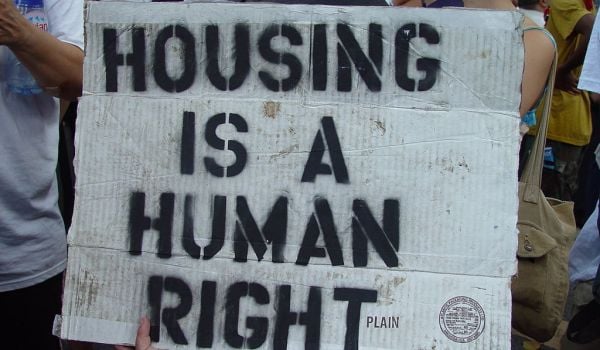In its heyday, Esther’s Orbit Room hosted Billie Holiday, Charlie Parker and John Coltrane, among other greats. The Oakland club — the cornerstone of a commercial corridor known as the “Harlem of the West” was owned and run by Texas native Esther Mabry, who had saved up her tips from waitressing to open, in 1950, the bar that would become the legendary jazz club.
If Mabry’s club was legendary, so was Mabry herself: 3rd-generation West Oaklander Noni Session remembers her for the annual scholarship she gave out to a C-grade student — indicative of caring for those that the system left behind.
Esther’s Orbit Room closed in 2010, and not long after, Mabry herself passed away. The building has been vacant ever since.
But now Session is shepherding a new effort to revitalize the property as an anchor for the revitalization of the entire 7th Street commercial corridor. The plan is to re-open the space as an arts and culture hub, including a gallery space and a performance space, as well as space for incubating food businesses, with three apartment units above. In late March, as executive director of the East Bay Permanent Real Estate Cooperative, she reached an agreement to acquire the property for $1.45 million from the current private owners.
It will be the third property and first commercial property for East Bay Permanent Real Estate Cooperative, a unique real estate development entity with an ownership and governance structure that includes co-op residents, members of the surrounding community, staff of the co-op, and investors — with residents, community members and staff having priority over investors in making major decisions and setting policies.
And East Bay Permanent Real Estate Cooperative is now looking for new investor-owners to join its cause. It’s looking to raise $50 million in shares through what’s known as a direct public offering. At a price of $1,000 a share, investor-owners are offered a target annual return of 1.5 percent. Unlike buying a share on the stock market, investors can’t sell their shares to others, only back to the co-op. And they have to leave their investment in the co-op for at least five years. Most importantly, no matter how many shares an investor purchases, each investor gets only one vote in the elections for board president and board treasurer.
The co-op has already secured the funding to acquire Esther’s Orbit Room, but the first $1.25 million from the offering will go to help renovate the building and bring it up to code. The co-op hopes the project will also provide a narrative to draw in investors to raise the remaining $48 million, and their investments will help finance projects that are already coming into the co-op’s pipeline. The co-op reviewed more than 35 potential projects in 2020.
“Esther’s would demonstrate our growing capacity to develop a project, and demonstrate conceptually that a non-extractive commercial project works, and that sets us up for the next dominos to fall all along the corridor and beyond,” Session says.
It wasn’t always this way, but today there is about as much investor capital being raised or invested outside stock and bond markets as inside them. The investment landscape has changed, from regulatory changes to Wall Street convincing businesses it’s easier to raise capital this way, or convincing pension funds and other big clients that higher returns could be found outside of stock and bond markets.
But the vast majority of these kinds of investment opportunities haven’t been very open to the general public, if at all. The U.S. Securities and Exchange Commission still tightly regulates investment offerings even outside of stock and bond markets. For decades, it mostly restricted these opportunities only to investors who it considered “sophisticated” enough to understand the risk.
The main factors the SEC uses to determine whether an investor is sophisticated enough for investments outside of the stock markets and bond markets are actually very simple, some would say too simple: net worth and income. If you have a net worth of at least $1 million, or annual income of at least $200,000 for the last two years (or $300,000 in combined income as a married couple), you’re what the SEC calls an “accredited investor,” and you can make these kinds of investments without restrictions.
For businesses or developers that might want to tap into that market of investors, these SEC restrictions essentially meant they couldn’t advertise those investment opportunities to the public. Solicitations had to be done very privately, in closed-door meetings or closed phone calls. As a result, until recently it’s only been already wealthy investors — from family inheritance or maybe from selling off their own startups — who have had access to these investment opportunities. Since these are often early-stage investments that would later go public, it helped balloon their wealth even further, adding to existing wealth disparities along racial or gender lines.
And since the investors who had access to these opportunities were mostly white men, they mostly invested in white men. Venture capital investments generally fall into this category of investing, and 98 percent of venture capital investments still go to firms owned by men, the vast majority of whom are white.
A few years ago, some things started to change. On April 5, 2012, the Jumpstart Our Business Startups (JOBS) Act was signed into law by President Barack Obama. The law promised to open up these kinds of investments to non-wealthy investors — what the SEC calls “non-accredited investors.” It took several years for the SEC to finalize regulations around the law, but when those regulations finally went into effect in 2016, many were already hopeful it would level the playing field for businesses owned by women or people of color by greatly diversifying the universe of possible investors.
Also by 2016, a number of online platforms had already started to emerge to court investors outside of stock markets and bond markets. At first they were only open to accredited investors, but they mostly were designed in anticipation of things soon opening up to non-accredited investors. In real estate, developers have long used “other people’s money” to finance projects, so it’s no surprise some of the earliest online investment platforms exclusively listed opportunities to invest in real estate projects.
It wasn’t impossible to do a direct public offering before the JOBS Act rules were in place, but it was much more difficult, and it was hard to find lawyers who were willing to test the legal limits of the law. But the Bay Area and California more broadly became a hub for these kinds of investment opportunities. Attorney Jenny Kassan, currently a city council member in Fremont, California, was one of the early pioneers in this space. She also served on the SEC’s Advisory Committee on Small and Emerging Companies, which helped write the JOBS Act rules, until that body expired in 2017.
With its direct public offering, East Bay Permanent Real Estate Cooperative is a rare example of this kind of investment opportunity in the cooperative space. In 2013, Massachusetts-based Real Pickles raised $500,000 from 77 local investors through a direct public offering, which helped it convert from a sole proprietorship into a worker-owned cooperative. CERO, a worker-owned food composting cooperative in Boston, raised $340,000 from 83 investors through direct public offering in 2015. Urban Green Food Co-op in Providence, Rhode Island, launched a direct public offering in 2016.
“We’ve been planning to do some kind of direct public offering since our inception,” says Ojan Mobedshahi, finance director and board treasurer at East Bay Permanent Real Estate Cooperative.
The co-op did a limited public offering back in 2019, to raise some of the capital for its first project — limited to California residents, and limited to $1,000 per investor, under the state’s cooperative laws that allow a co-op to raise capital from its members. It got the co-op’s feet wet in the process of courting new investor-owners, explaining to them the benefits and also the real risks of investing in this particular co-op, with its mission and unique governance structure.
And it was an early success. East Bay Permanent Real Estate Cooperative raised $160,000 from 160 investors in its first limited public offering. Investors bought into the co-op’s vision for taking land off of the speculative market, sharing property ownership with the residents on that land and in the surrounding community, and giving those residents and the community more power in the governance structure of the co-op.
Because it was limited to California residents, the first offering did not require filing any paperwork with the SEC to comply with federal securities law. The true direct public offering East Bay Permanent Real Estate Cooperative is doing now did require drafting and filing an extensive document with the SEC. It’s known as an offering circular.
Drafting the co-op’s offering circular essentially boiled down to converting the language and concepts from the documents involved in its earlier limited public offering into the SEC’s required input format.
Those earlier limited public offering documents, like the co-op’s bylaws, were designed intentionally to be accessible and relatable. They included hand-drawn cartoons to illustrate key concepts — a trademark of attorney Janelle Orsi and the Sustainable Economies Law Center, or SELC, which helped incubate East Bay Permanent Real Estate Cooperative and still works closely with them as a client.
Suffice it to say, you cannot submit cartoons to the SEC.
“In order to file this offering circular, you can’t just upload a word document or PDF,” Mobedshahi says. “You have to use the SEC’s online platform, EDGAR. There’s a whole industry of companies that do ‘EDGARization’ — taking your information you provide and formatting it appropriately to enter into EDGAR itself.”
The co-op bit the bullet and paid a thousand dollars to use an EDGARization platform. Normally this kind of offering calls for bringing in specialized legal counsel, which can run anywhere from $10,000-$30,000 or more, typically. But the co-op wanted to keep its costs down, and also SELC was willing to get deep enough in the weeds so that it could guide more partners through the process in the future.
Also it turned out that despite their challenging digital interface, the SEC staff themselves were actually pretty helpful, according to Mobedshahi. There was one round of feedback that the SEC gave, which required the co-op to amend its offering slightly.
“The EDGAR platform is extremely inaccessible, but the people at the SEC were very accessible,” Mobedshahi says. “It’s definitely a huge process, but they don’t try to make it more difficult than it already is.”
The co-op submitted its offering circular in July 2020, and by September it was approved.
It was a lot of work, but the offering circular opens the door to investors from other states, and there are higher limits per investor. Accredited investors don’t have any limits at all for investing in this type of offering. Non-accredited investors may invest up to 10 percent of their net worth or annual income, whichever is greater. So the co-op has set its sights much higher than its earlier limited public offering, hoping to raise $50 million from investors across the country over the next three years to help finance multiple projects for the co-op. Some states require additional filing fees or paperwork, so the co-op is prioritizing states based on ease of applying and investor demand. So far East Bay Permanent Real Estate Cooperative is welcoming investors from California, Delaware, Missouri, Pennsylvania, Alaska, Connecticut, Georgia, Massachusetts, Maryland, Oregon and Colorado.
“We are really owning up to being both a movement-oriented cooperative real estate organization and being a land and housing fund, which means we take funds in and invest them and manage those funds to acquire multiple properties and take them off of the speculative market permanently,” says Annie McShiras, who joined EBPREC in September 2020 as investment and fundraising director.
The investment is not without risk. As described in the co-op’s offering circular, “Fluctuation of property values could create challenges,” so the co-op will mitigate that by “diversifying property types and locations,” “negotiating property purchases before they are put on the market,” and by “advocating for public policies that stabilize markets and make real estate more affordable to organizations like EB PREC.”
“EB PREC will have limited liquidity,” so the co-op will mitigate that by “keeping some reserves in liquid investments,” “developing partnerships with financial institutions that facilitate liquidity,” “refinancing properties to access cash when needed,” and by “giving Investor Owners the option to not to receive dividends.”
For the risk that “Tenants’ economic distress could affect the Cooperative’s financial stability,” there is no mitigation strategy. That’s just a risk that investors need to be aware of.
As the offering circular reads, “When tenants cannot make required payments to EB PREC, EB PREC plans to seek alternatives to eviction, such as by providing grace periods, offering payment plans, and seeking other creative solutions to support tenants. Many of EB PREC’s target residents are already experiencing economic distress due to systemic discrimination and oppression. Therefore, EB PREC may elect to not use conventional credit histories or other traditional metrics in the selection of tenants, which may increase the risk of non-payment by tenants.”
But as risky as it sounds, the success of the previous California-only offering proved there is a demand for this kind of investment. Even just limited to California, that first offering received more offers from investors than it needed. Half of those investors even declined to receive any dividends.
For Session, revitalizing the building and eventually the rest of the corridor would carry extra significance. Her father used to own a corner grocery a few blocks down on 7th Street. Mabry’s building also housed an adjacent convenience store that Session used to visit as a child.
“It was kind of chilling, kind of emotional for me, in a certain kind of way because my father has passed, and that was a regular stop on the way to a pier which we visited more than once a week when I was a kid,” Session says. “He would stop and get ice and get me a cupcake and a soda, and we’d go to the 7th street pier. He would fish and I would play in the dirt and the rocks and catch crabs. It’s a deep history, it’s like a four-generation history for Esther’s Orbit Room.”
Editor’s note: We’ve clarified the language around the annual returns offered in this investment and added Oregon as an eligible state.
This article is part of The Bottom Line, a series exploring scalable solutions for problems related to affordability, inclusive economic growth and access to capital. Click here to subscribe to our Bottom Line newsletter.

Oscar is Next City's senior economic justice correspondent. He previously served as Next City’s editor from 2018-2019, and was a Next City Equitable Cities Fellow from 2015-2016. Since 2011, Oscar has covered community development finance, community banking, impact investing, economic development, housing and more for media outlets such as Shelterforce, B Magazine, Impact Alpha and Fast Company.
Follow Oscar .(JavaScript must be enabled to view this email address)



_920_518_80.jpg)



_920_614_600_350_80_s_c1.jpg)

_600_350_80_s_c1.JPG)








